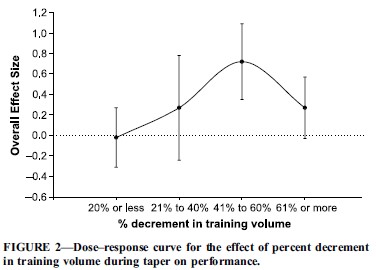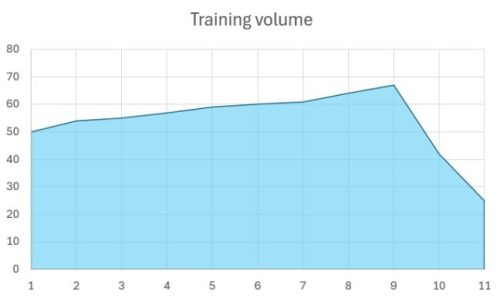Ever wondered how to get the perfect race taper? Picture this. You’ve been training for an Olympic distance triathlon, and now you’re only 2 weeks from race day. You don’t want to rest because you’ll lose fitness. You don’t want to keep training hard because you might burn out or get injured. Should you:
A) Train normally until a few days before race day.
B) Only do easy sessions for the next two weeks.
C) Do several hard sessions at race pace to ‘tune-up’.
What intensity, distance, duration and type of exercise should you do to perform at your peak come race day? In this article, we look at the research behind the taper. What a taper is, how important it is, and how you can get the perfect taper at your next race.
What is a race taper
The race taper is a reduction in the training load of athletes in the final days before an important competition, with the aim of optimising performance. This reduction of the training load can be achieved by changing several components, including the volume, duration, intensity and frequency.

How important is a taper
Tapering is very important both physically and mentally. It has been observed that a good taper improves marathon performance by 3%. [1] Throughout a marathon that would be about 5-10 minutes. So why does a taper improve performance?
The first is that your body can fully recover from the training load placed on it week after week. Your muscles, tendons, ligaments and other tissues get the chance to fully recover from the micro-damage that occurs with training. This is also the cause of delayed onset muscle soreness after gym training. [2] When the overall training load reduces during a taper, less micro-damage will occur and you can recover more quickly after the session. This enhanced recovery ultimately results in you being fresher for race day.
Secondly, there are several psychological benefits. Research shows that tapering improves mood and decreases the perception of effort. [3] These benefits have even been thought to be the driving factors contributing to improved performance after a taper. Don’t underestimate the power this psychology has on your race taper.
Finally, your body will absorb and store up to the maximum amount of glycogen in your muscles and liver during carbohydrate loading. Glycogen is used as fuel during moderate to high-intensity exercise. Generally, your body will only be able to store about 2 hours’ worth of this fuel. However, during a normal training block, these stores will often remain slightly depleted. Maximising the availability of this fuel source will enable you to race harder on race day. Carbohydrate loading is performed during the last few days of your taper. Carbohydrate loading is discussed in this article.
Making sure you get a good taper will help you feel better, perform better and race harder. So what is the best taper for you?
How to get the perfect taper
A large study looked at many different methods commonly used to taper. What they found may be surprising. The study compared different taper techniques in swimmers, cyclists, runners, rowers, and triathletes. [4] They found that the taper method with the biggest impact lasted 8-14 days, and maintained training frequency and intensity, but reduced duration. Tapers that lasted less than 7 days or longer than 14 days were only half as impactful. Similarly, tapers that decreased training volume by less than 40% or more than 60% were less impactful. Finally, it showed that decreasing the training intensity causes a (very small) negative effect on performance after the taper. With this in mind, the perfect taper is described below:

Intensity:
Maintain the same high-intensity training that you have been doing. Research shows that reducing intensity hurts your taper.
Olympic distance and longer: Typically maintain 95–105% of race pace during hard sessions.
Sprint distance and shorter: Typically maintain 100–110% of goal race pace during hard session.
Volume:
Reduce your overall volume by 41–60% during the taper.
In the first half of your taper reduce volume by 25%, in the second half, reduce by another 25%. This lands you at half your previous training volume.
Reducing volume means reducing the volume of easy exercise and the volume of hard exercise.
Eg. If a hard running session usually looks like 8x800m, then reducing volume by 25% would require you to do 6x800m in the first half of your taper and do 4x800m in the second half.
Frequency:
Keep your rhythm alive. Maintain your training frequency leading up to your race. This has both psychological and physiological benefits on race day. You should maintain your routine while freshening up from the reduced overall volume.
Taper Timing:
The ideal time to start is 8–14 days before the big race.
If you are feeling more fatigued than usual then a 14-day taper is the one for you.
Feeling fresh? Do the shorter 8-day taper. Feel free to play around and see what works best for you. I race best off the 8-day taper.
Carbohydrate loading:
As discussed above, the carb load is also an important part of the taper. It ensures you have maximum energy availability on race day.
Summary:
The taper lasts 8-14 days. Any longer or shorter will not be as beneficial. Reduce overall volume progressively to 41- 60% of your pre-taper volume. Maintain your training frequency and intensity! Carbohydrate load during the last few days of your taper to maximise your fuel stores so you can race harder.
[1] Hopkins, W., and Hewson, D., 2001, Variability of competitive performance of distance runners.
[2] Murach, K.A. and Bagley, J.R., 2015, Less Is More: The Physiological Basis for Tapering in Endurance, Strength, and Power Athletes.
[3] Coutts, A.J., et al., 2007, Monitoring changes in performance, physiology, biochemistry, and psychology during overreaching and recovery in triathletes.
[4] Bosquet, L. et al., 2007, Effects of Tapering on Performance: A Meta-Analysis.


Leave a Reply